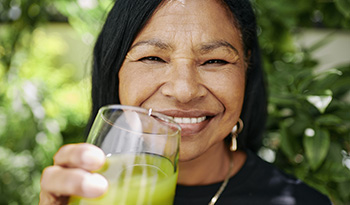الأعشاب الطبيعية والصحة المعرفية

القيود المفروضة على العلاجات التقليدية تدعو لتعزيز دراسات وبحوث الأعشاب
الخرف هو مرض انتكاسي عصبي يتسبب في إعاقات تدريجية في الذاكرة والتعلم والأداء التنفيذي وأنشطة الحياة اليومية. هناك أكثر من 47.5 مليون شخص يعانون من الخرف في جميع أنحاء العالم، ويتم إضافة 7.7 مليون حالة جديدة إلى تجمع مرض الخرف كل عام. ترتبط زيادة خطر الإصابة بالخرف الوعائي (VaD) بالسمنة وارتفاع ضغط الدم وأمراض القلب والأوعية الدموية والحوادث الوعائية الدماغية (أي السكتة الدماغية). يمثل مرض الخرف الوعائي (VaD) ما بين 10% إلى 15% من جميع حالات الخرف في البلدان الصناعية و 30% من حالات الخرف في مناطق العالم الأقل نموًا وهو ثاني أكثر أشكال الخرف انتشارًا بعد مرض الزهايمر (AD). أكثر من 40% من حالات الخرف الوعائي (VaD) تعاني أيضًا من أمراض الانتكاس العصبي مثل مرض الزهايمر (AD)، والذي يمثل أكثر أنواع الخرف المختلط شيوعًا.
العوامل الدوائية المتاحة مثل مثبطات الكولينستراز ومضادات مستقبلات الغلوتامات مفيدة في بعض حالات الإصابة بمرض الزهايمر (AD) ولكن لها فعالية محدودة ضد مرض الخرف الوعائي (VaD). ونتيجة لذلك توجه العديد من الأشخاص الذين يعانون من مرض الخرف الوعائي (VaD) إلى استخدام الأعشاب والنُهج التكميلية البديلة الأخرى (CAM) مثل الوخز بالإبر، والمغذيات، واليوغا، والتاي تشي، والعلاج بالموسيقى.
تمت دراسة وفحص العديد من الأعشاب المستخدمة في الطب الصيني بشكل فردي وبأشكال المجموعات المختلفة للتحقق من آثارها المفيدة المحتملة على أعراض مرض الزهايمر (AD) ومرض الخرف الوعائي (VaD)، بما في ذلك عشبة جنكو بيلوبا، عشبة هوبرزيا سيراتا، عشبة الكركم الطويل، عشبة جنسنغ باناكس، عشبة جنسنغ يونان، عشبة باكوبا مونيري, عشبة سالفيا ميلتوريهيزا، عشبة الزعفران السوسني، وعشبة الكاميليا الصينية. وفيما يلي استعراض موجز للدراسات التي أجريت على الأعشاب المستخدمة في الطب الصيني بشكل فردي وبأشكال المجموعات المختلفة للتحقق من آثارها المفيدة المحتملة لدى البالغين الأصحاء والأفراد المصابين بالخرف.
الأعشاب الأحادية مفيدة ولكن فائدتها محدودة
النتائج الأخيرة تشير إلى أن خلاصة عشبة جنكو بيلوبا تعمل على تحسين التعلم والذاكرة لدى النماذج الحيوانية المصابة بمرض الخرف الوعائي (VaD). تشير الدراسات التي أُجريت على مجموعات كبيرة باستخدام العلاج الوهمي بالإضافة إلى التحليلات التجميعية للدراسات التي تلبي معايير الاشتمال الدقيقة إلى أن خلاصة عشبة جنكو بيلوبا تعمل على إبطاء معدل الانخفاض في الإدراك والأداء التنفيذي والسلوك لدى الأفراد المصابين بمرض الزهايمر (AD) ومرض الخرف الوعائي (VaD). الآليات المقترحة التي تجعل من عشبة جنكو بيلوبا تعزز وظائف المخ مما يؤدي إلى تحسين الذاكرة والأداء المعرفي، ويشمل انخفاض نشاط البلاعم المؤيدة للالتهابات، وتحسين تدفق الدم، وانخفاض نشاط عامل تنشيط الصفائح الدموية (مما يقلل من خطر السكتة الدماغية)، وانخفاض إنتاج الكورتيكوستيرويد وزيادة امتصاص الجلوكوز، وتعزيز تكاثر الخلايا الجذعية العصبية، تسارع اللدونة التشابكية بعد إصابة الدماغ، وتقليل تدفق الكوليسترول الحر، وتقليل إنتاج سلائف بروتين أميلود بيتا.
الكركم الطويل (الكركم) كان يُستخدم لعدة قرون في الطب الصيني والهندوسي والأيروفيدا (علم الحياة) في علاج العديد من الاضطرابات الطبية بما في ذلك التهاب البنكرياس والتهاب المفاصل والسرطان والالتهابات الانتكاسية العصبية واضطرابات الجهاز الهضمي. تشير الدراسات التي أجريت على الحيوانات وكذلك الدراسات المختبرية إلى أن الفوائد المعرفية المعززة للكركم تستند إلى آليات عملية متعددة بما في ذلك تثبيط بيروكسيد الدهون، وكسح أنواع الأكسجين التفاعلي (ROS)، وكسح أنواع النيتروجين التفاعلي، وتثبيط تنشيط NF-kB، بالإضافة إلى دوره كمضاد للالتهابات. قد يربط الكركمين أيضًا أنواع بيتا أميلويد الصغيرة لأجل عرقلة تجميع وتشابك الألياف الليفية. في تجربة إكلينيكية عشوائية تمت على مدار 24 شهرًا، استخدم 36 مريضًا يعانون من مرض الزهايمر (AD)، بدرجة خفيفة إلى معتدلة، الكركم (2 و 4 جم/يوم) في مقابل مجموعة تم علاجها بالعلاج الوهمي وكانت النتيجة عدم وجود فوارق هامة بين المجموعتين من حيث علاج الإدراك والذاكرة. قد يرجع جزء من السبب وراء هذ النتيجة إلى التوافر البيولوجي المنخفض أثناء إعداد الكركم المستخدم في الدراسة.
نتائج الدراسات التي أُجريت على الحيوانات تشير إلى أن المكونات النشطة بيولوجيا من عشبة جنسنغ باناكس قد تحسن الإدراك والذاكرة لدى المرضى الذين يعانون من الخرف. جنسنوسد (Rg5) يقلل أميلود بيتا ونشاط الكولينستراز، ويعزز الجنسنوسد Rg3 بيتاتدهور الببتيد أميلود من خلال تعزيز التعبير الجيني. عشبة جنسنغ باناكس قد تقلل أيضًا من ضغط الدم وتحسن الدورة الدموية عن طريق تعزيز توسع الأوعية. تشير تجربتان مفتوحتان لمدة 12 أسبوعًا إلى أن نبات الجنسنغ قد يحسن الإدراك لدى الأفراد المصابين بمرض الزهايمر (AD). في تجربتين صغيرتين أخرتين مفتوحتين، قام الأفراد المصابون بمرض الزهايمر (AD) باستخدام عشبة جنسنغ باناكس بجرعات 4.5 و 9 جم/يوم، وكانت النتيجة ظهور تحسن ملحوظ في الإدراك والذاكرة. تشير نتائج تجربتين صغيرتين تم تطبيق العلاج الوهمي فيهما إلى أن عشبة جنسنغ يونان تحسن تدفق الدم في الدماغ وتعزز الذاكرة لدى الأفراد الذين يعانون من مرض الخرف الوعائي (VaD).
عشبة باكوبا مونيري (عشبة براهمي) تمتلك خصائص الحماية العصبية بالإضافة إلى الخصائص المضادة للأكسدة وتعمل كمنظف مستقل وقد تزيد من تدفق الدم إلى المخ. تُستخدم هذه العشبة على نطاق واسع في طب الأيورفيدا (علم الحياة) لعلاج مشاكل الذاكرة. أما بالنسبة للدراسات حول الفوائد المعرفية المعززة للأعشاب لدى البالغين الأصحاء والأشخاص المصابين بمرض الزهايمر (AD) فهي حاليًا قيد البحث.
الزعفران (الزعفران السوسني) يُستخدم في الطب الصيني كمضاد للاكتئاب ومضاد للتشنج ومضاد للجراثيم. خلاصته التي تحتوي على الكروسين لها خصائص مضادة للأكسدة ومضادة للصفيحات وقد ثبت أنها تحسن التعلم والذاكرة في النماذج الحيوانية التي تعاني من أمراض الخرف. في تجربة إكلينيكية عشوائية مزدوجة التعمية لمدة 22 أسبوعًا، أظهر المرضى الذين يعانون من مرض الزهايمر (AD) والذين استخدموا الزعفران 30 ملغ/يوم ومثبط الكولينستراز المنزلق 10 ملغ/يوم تحسينات مماثلة في الإدراك حيث كان الزعفران أكثر تواجدًا. وفي تجربة إكلينيكية عشوائية مزدوجة التعمية، استجاب الأشخاص المصابون بمرض الزهايمر (AD) الذين حصلوا على الزعفران خلال 16 أسبوعًا بشكل أفضل من المجموعة الثانية التي استخدمت العلاج الوهمي.
الشاي (عشبة الكاميليا الصينية) يُستهلك على نطاق واسع في تعزيز الصحة، ويحتوي على يبيغاللوكاتيشين-3-غالاتي (EGCG)، الذي يمتلك فوائد من حيث الحماية العصبية بوساطة الآثار المضادة للالتهابات، ودوره كمنظف جذري حر، وغير ذلك. الأفراد الذين يشربون الشاي بشكل متكرر قد يكون لديهم خطر أقل للإصابة بمرض الزهايمر (AD). وجدت دراستان مستقبليتان أن الاستهلاك المنتظم للشاي الأخضر لدى كبار السن يرتبط بانخفاض خطر الإصابة بضعف الإدراك والخرف نسبيًا.
نتائج الدراسات على الأعشاب الفردية من حيث علاج الخرف محدودة بأحجام عينة صغيرة من التجارب الإكلينيكية الفردية، ونوعية المنهجية الرديئة، ومدة الدراسة القصيرة. علاوة على ذلك، قد تكون تركيزات البلازما للعناصر النشطة بيولوجيًا للعديد من الأعشاب الفردية منخفضة جدًا بحيث لا يكون لها تأثيرات مفيدة، مما يشير إلى أن التحسن الملحوظ في الإدراك قد يكون مرتبطًا بتفاعلات التآزر بين اثنين أو أكثر من المكونات النشطة حيوياً. يستخدم الطب الصيني والأنظمة الآسيوية الأخرى في الطب مجموعات من الأعشاب، مما قد يؤدي إلى تفاعلات متآزرة بين المكونات النشطة حيوياً المنفصلة والتي قد تستهدف الأمراض ذات المسببات المعقدة بشكل أكثر فعالية مثل أمراض الزهايمر (AD) والخرف الوعائي (VaD). تم مؤخراً تطبيق طريقة بحث جديدة تسمى التحليل النظامي البيني لدراسة التفاعلات المعقدة المتآزرة في الصيغ العشبية.
المستقبل الواعد للصيغ العشبية المركبة
أجريت دراسات قليلة فقط على الصيغ العشبية المعقدة من حيث تأثيرها في علاج الخرف الوعائي (VaD). في حين أن البعض أبلغ عن نتائج إيجابية، إلا أن أهمية النتائج محدودة بحجم الدراسة الصغير والعيوب المنهجية. ذكرت مراجعة منهجية أُجريت عام 2012 على الدراسات التي أُجريت على الصيغ العشبية المعقدة في علاج الخرف الوعائي (VaD) أن غالبية الصيغ التي تم فحصها أسفرت عن تحسينات أكبر بكثير في الأداء المعرفي بالمقارنة مع الأدوية المستخدمة تقليديًا أو تلك المستخدمة ضمن أساليب العلاج الوهمي. أفادت 4 دراسات تم فيها الجمع بين الأدوية العشبية والأدوية التقليدية عن أداء إدراكي أفضل مقارنة بالأدوية التقليدية وحدها، ومع ذلك، فإن أهمية هذه النتائج محدودة بسبب العيوب المنهجية الخطيرة. تضمن التحليل التجميعي الأكثر حداثة 24 تجربة إكلينيكية عشوائية (أجريت جميعها في الصين) على الأفراد الذين تم تشخيصهم بمرض الخرف الوعائي (VaD). عند تحليل مجموعة فرعية من حيث دور الأعشاب الصينية المركبة، ظهر أن تلك الأعشاب عززت بشكل كبير الوظيفة المعرفية بالمقارنة مع بيراسيتام (في 10 دراسات) أو الدواء الوهمي (في 3 دراسات). شهد الأفراد الذين يتلقون الأدوية العشبية تحسينات أكبر في أنشطة الحياة اليومية مقارنة مع أولئك الذين عولجوا باستخدام بيراسيتام. ومع ذلك، فكما هو الحال في الدراسات المذكورة أعلاه، كانت أهمية النتائج محدودة بسبب العيوب المنهجية.
الجهود المستمرة لتطوير صيغة عشبية مركبة للخرف الوعائي
استجابة للتحديات المذكورة أعلاه والتي استمرت لأكثر من عقد من الزمان، كان هناك جهد تعاوني مستمر بين أكاديمية العلوم الطبية الصينية وجامعة سيدني الغربية لتطوير تركيبة عشبية موحدة لعلاج مرض الخرف الوعائي (VaD). تحتوي الصيغة، المسماة SLT، على التركيبات الموحدة لخلاصات عشبة جنكو بيلوبا (جنكو)، عشبة جنسنغ باناكس (جنسنغ)، وعشبة الزعفران السوسني (الزعفران) .
تم تحديد النسبة المثلى من المكونات النشطة بيولوجيًا والجرعة المثلى من SLT من خلال سلسلة من الدراسات على الحيوانات. أظهرت التجارب قبل الإكلينيكية تحسنًا كبيرًا في التعلم والذاكرة، وأعراض الأمراض العصبية والأنشطة المضادة للأكسدة لدى النماذج الحيوانية التي تعاني من الخرف. وفي وقت كتابة هذا التقرير، تجري دراسات المرحلة الثالثة الكبيرة لتحديد الفعالية لدى الأفراد الذين تم تشخيص إصابتهم بمرض الخرف الوعائي (VaD). وقد أظهرت النتائج التراكمية من التجارب قبل الإكلينيكية العديد من الفوائد الدماغية لـ SLT بما في ذلك انخفاض مجالات الإصابة بنقص التروية الدموية، وانخفاض تراكم الصفائح الدموية، وزيادة نشاط تنظيف الجذور الحرة.
الأفراد الذين عولجوا بـ SLT أو الدواء الوهمي يعانون من نفس خطر الآثار الضارة. في تجربة صغيرة عشوائية تمت لمدة أسبوع واحد، استخدم 16 من البالغين الأصحاء الذين تم اختيارهم بصورة عشوائية مركب SLT ونتج عنه تحسينات في ذاكرة العمل. في مرحلة صغيرة من الدراسة الثانية، أظهر الأفراد الذين شُخصت إصابتهم بمرض الخرف الوعائي (VaD) والذين استخدموا مركب SLT تحسنًا أكبر بكثير في الأداء المعرفي، وأظهرت مجموعة فرعية زيادة في تدفق الدم في مناطق المخ المرتبطة بالذاكرة والسمع ومعالجة الكلام. ووجدت دراسة ثانية استمرت لفترة 12 شهرًا في المرحلة الثانية على 325 شخصًا يعانون مرض الخرف الوعائي (VaD) والذين استخدموا مركب SLT أن هناك تحسنات معرفية مماثلة، كما أن دراسة أخرى عن المرحلة الثانية أبلغت عن أحداث سلبية خطيرة متعلقة بمركب SLT. في وقت كتابة هذا التقرير، كانت تجربتا للمرحلة الثالثة متعددة المراكز قيد التطبيق. وفي انتظار التأكيد لنتائج المرحلة الثالثة، قد يظهر بالدليل أن مركب SLT هو علاج عشبي لمرض VsD، وهو اضطراب انتكاسي عصبي لا يوجد علاج فعال له في الوقت الحالي.
المراجع:
- Chang et al Herbal Medicine for theTreatment of Vascular Dementia: An Overview of Scientific Evidence 2016)
- Dementia Fact Sheet, World Health Organization, 2016.
- N. Kalaria, G. E. Maestre, R. Arizaga et al., “Alzheimer’s disease and vascular dementia in developing countries: prevalence, management, and risk factors,” The Lancet Neurology, vol. 7, no. 9, pp. 812–826, 2008.
- K. A. Nolan, M. M. Lino, A. W. Seligmann, and J. P. Blass, “Absence of vascular dementia in an autopsy series from a dementia clinic,” Journal of the American Geriatrics Society, vol. 46, no. 5, pp. 597–604, 1998.
- M. R. Farlow, M. L. Miller, and V. Pejovic, “Treatment options in Alzheimer’s disease: maximizing benefit, managing expectations,” Dementia and Geriatric Cognitive Disorders, vol. 25, no. 5, pp. 408–422, 2008.
- D. A. Levine and K. M. Langa, “Vascular cognitive impairment: disease mechanisms and therapeutic implications,”Neurotherapeutics, vol. 8, no. 3, pp. 361–373, 2011.
- H. Shim, “Vascular cognitive impairment and post-stroke cognitive deficits,” Current Neurology and Neuroscience Reports, vol. 14, no. 1, article 418, 2014.
- P. C. Chan, Q. Xia, and P. P. Fu, “Ginkgo biloba leave extract: biological, medicinal, and toxicological effects,” Journal of Environmental Science and Health. Part C, Environmental Carcinogenesis & Ecotoxicology Reviews, vol. 25, no. 3, pp. 211–244, 2007.
- J. Wang, W. Chen, and Y. Wang, “A ginkgo biloba extract promotes proliferation of endogenous neural stem cells in vascular dementia rats,” Neural Regeneration Research, vol. 8, no. 18, pp. 1655–1662, 2013.
- L.-Y. Zhang and Y.-L.Wang, “[Effects of EGb761 on hippocampal synaptic plasticity of vascular dementia rats],” Chinese journal of applied physiology, vol. 24, no. 1, pp. 36–40, 2008.
- Z.-X. Yao, Z. Han, K. Drieu, and V. Papadopoulos, “Ginkgo biloba extract (Egb 761) inhibits amyloid production by lowering free cholesterol levels,” Journal of Nutritional Biochemistry, vol. 15, no. 12, pp. 749–756, 2004.
- M. Hrehorovsk´a, J. Burda, I. Domor´akov´a, and E. Mech´ırov´a, “Effect of Tanakan on postischemic activity of protein synthesis machinery in the rat brain,” General Physiology and Biophysics, vol. 23, no. 4, pp. 457–465, 2004.
- P.-O. Koh, “Gingko biloba extract (EGb 761) prevents cerebral ischemia-induced p70S6 kinase and S6 phosphorylation,” American Journal of Chinese Medicine, vol. 38, no. 4, pp. 727–734, 2010.
- S. Saleem, H. Zhuang, S. Biswal, Y. Christen, and S. Dor´e, “Ginkgo biloba extract neuroprotective action is dependent on heme oxygenase 1 in ischemic reperfusion brain injury,” Stroke, vol. 39, no. 12, pp. 3389–3396, 2008.
- B. Spinnewyn, N. Blavet, and F. Clostre, “[Effects of ginkgo biloba extract on a cerebral ischemia model in gerbils],” Presse Medicale, vol. 15, no. 31, pp. 1511–1515, 1986.
- M.-N. Rocher, D. Carr´e, B. Spinnewyn et al., “Long-term treatment with standardized Ginkgo biloba Extract (EGb 761) attenuates cognitive deficits and hippocampal neuron loss in a gerbil model of vascular dementia,” Fitoterapia, vol. 82,no. 7, pp. 1075–1080, 2011.
- W.-Z. Li,W.-Y.Wu, H. Huang, Y.-Y.Wu, and Y.-Y. Yin, “Protective effect of bilobalide on learning and memory impairment in rats with vascular dementia,” Molecular Medicine Reports, vol. 8, no. 3, pp. 935–941, 2013.
- L. S. Schneider, “Ginkgo biloba extract and preventing Alzheimer disease,” JAMA, vol. 300, no. 19, pp.2306–2308,2008.
- R. Ihl, M. Tribanek, N. Bachinskaya, and Gotaday Study Group, “Efficacy and tolerability of a once daily formulation of Ginkgo biloba extract EGb 761(R) in Alzheimer’s disease and vascular dementia: results from a randomised controlled trial,” Pharmacopsychiatry, vol. 45, no. 2, pp. 41–46, 2012.
- S. Gauthier and S. Schlaefke, “Efficacy and tolerability of Ginkgo biloba extract EGb 761_ in dementia: a systematic review and meta-analysis of randomized placebo-controlled trials,” Clinical Interventions in Aging, vol. 9, pp. 2065–2077, 2014.
- M.-S. Tan, J.-T. Yu, C.-C. Tan et al., “Efficacy and adverse effects of Ginkgo Biloba for cognitive impairment and dementia: a systematic review and meta-analysis,” Journal of Alzheimer’s Disease, vol. 43, no. 2, pp. 589–603, 2015.
- Y. Wang, L.-Q. Huang, X.-C. Tang, and H.-Y. Zhang, “Retrospect and prospect of active principles from Chinese herbs in the treatment of dementia,” Acta Pharmacologica Sinica, vol. 31, no. 6, pp. 649–664, 2010.
- J. M. Ringman, S. A. Frautschy, G. M. Cole, D. L. Masterman, and J. L. Cummings, “A potential role of the curry spice curcumin in Alzheimer’s disease,” Current Alzheimer Research, vol. 2, no. 2, pp. 131–136, 2005.
- F. Yang, G. P. Lim, A. N. Begum et al., “Curcumin inhibits formation of amyloid oligomers and fibrils, binds plaques, and reduces amyloid in vivo,” The Journal of Biological Chemistry, vol. 280, no. 7, pp. 5892–5901, 2005.
- J. M. Ringman, S. A. Frautschy, E. Teng et al., “Oral curcumin for Alzheimer’s disease: tolerability and efficacy in a
- 24-week randomized, double blind, placebo-controlled study,” Alzheimer’s Research andTherapy, vol. 4, no. 5, article 43, 2012.
- S. Chu, J. Gu, L. Feng et al., “Ginsenoside Rg5 improves cognitive dysfunction and beta-amyloid deposition in STZ induced memory impaired rats via attenuating neuroinflammatory responses,” International Immunopharmacology, vol. 19,no. 2, pp. 317–326, 2014.
- H. Yang, J. Zhang, R. M. Breyer, and C. Chen, “Altered hippocampal long-term synaptic plasticity in mice deficient in the PGE2 EP2 receptor,” Journal of Neurochemistry, vol. 108, no. 1, pp. 295–304, 2009.
- J.-X. Liu, W.-H. Cong, L. Xu, and J.-N. Wang, “Effect of combination of extracts of ginseng and ginkgo biloba on acetylcholine in amyloid beta-protein-treated rats determined by an improved HPLC,” Acta Pharmacologica Sinica, vol. 25, no.9, pp. 1118–1123, 2004.
- J. Shi, S. Zhang, M. Tang et al., “The 1239G/C polymorphism in exon 5 of BACE1 gene may be associated with sporadic Alzheimer’s disease in Chinese Hans,” American Journal of Medical Genetics Part B: Neuropsychiatric Genetics, vol. 124, no. 1, pp. 54–57, 2004.
- Y. Sun, J. Ke, N. Ma, Z. Chen, C. Wang, and X. Cui, “[Effects of root rot on saponin content in Panax notoginseng],” Zhong yao cai = Zhongyaocai = Journal of Chinese medicinal materials, vol. 27, no. 2, pp. 79–80, 2004.
- K.-T. Choi, “Botanical characteristics, pharmacological effects and medicinal components of Korean Panax ginseng CA Meyer,” Acta Pharmacologica Sinica, vol. 29, no. 9, pp. 1109–1118, 2008.
- J.-H. Heo, S.-T. Lee, K. Chu et al., “An open-label trial of Korean red ginseng as an adjuvant treatment for cognitive impairment in patients with Alzheimer’s disease,” European Journal of Neurology, vol. 15, no. 8, pp. 865–868, 2008.
- S.-T. Lee, K. Chu, J.-Y. Sim, J.-H. Heo, and M. Kim, “Panax ginseng enhances cognitive performance in Alzheimer disease,” Alzheimer Disease and Associated Disorders, vol. 22, no. 3, pp. 222–226, 2008.
- J.-H. Heo, S.-T. Lee, M. J. Oh et al., “Improvement of cognitive deficit in Alzheimer’s disease patients by long term treatment with Korean red ginseng,” Journal of Ginseng Research, vol. 35, no. 4, pp. 457–461, 2011.
- J. Tian, “Ginseng may improve memory in stroke dementia patients,” in Proceedings of the American Stroke Association Meeting, Augusta, Canada, 2003.
- Q. F.Gui,Y.M.Yang, S. H. Ying, andM. M. Zhang, “Xueshuantong improves cerebral blood perfusion in elderly patients with lacunar infarction,” Neural Regeneration Research, vol. 8, no. 9, pp. 792–801, 2013.
- A. Russo and F. Borrelli, “Bacopamonniera, a reputed nootropic plant: an overview,” Phytomedicine, vol. 12, no. 4, pp. 305–317, 2005.
- S. K. Bhattacharya, A. Bhattacharya, A. Kumar, and S. Ghosal, “Antioxidant activity of Bacopa monniera in rat frontal cortex, striatum and hippocampus,” Phytotherapy Research, vol. 14, no. 3, pp. 174–179, 2000.
- A. Russo, A. A. Izzo, F. Borrelli, M. Renis, and A. Vanella, “Free radical scavenging capacity and protective effect of Bacopa monniera L. on DNA damage,” Phytotherapy Research, vol. 17, no. 8, pp. 870–875, 2003.
- N. Kamkaew, C. N. Scholfield, K. Ingkaninan, N. Taepavarapruk, and K. Chootip, “Bacopa monnieri increases cerebral blood flow in rat independent of blood pressure,” Phytotherapy Research, vol. 27, no. 1, pp. 135–138, 2013.
- C. Stough, A. Scholey, V. Cropley et al., “Examining the cognitive effects of a special extract of Bacopa monniera (CDRI08: Keenmind): a review of ten years of research at Swinburne University,” Journal of Pharmacy and Pharmaceutical Sciences, vol. 16, no. 2, pp. 254–258, 2013.
- C. K. Stough, M. P. Pase, V. Cropley et al., “A randomized controlled trial investigating the effect of Pycnogenol and Bacopa CDRI08 herbal medicines on cognitive, cardiovascular, and biochemical functioning in cognitively healthy elderly people: theAustralian ResearchCouncil Longevity Intervention (ARCLI) study protocol (ANZCTR12611000487910),” Nutrition Journal, vol. 11, article 11, 2012.
- K. Abe and H. Saito, “Effects of saffron extract and its constituent crocin on learning behaviour and long-term potentiation,” Phytotherapy Research, vol. 14, no. 3, pp. 149–152, 2000. H. Hosseinzadeh and T. Ziaei, “Effects of Crocus sativus stigma extract and its constituents, crocin and safranal, on intact memory and scopolamine−induced learning deficits in rats performing the Morris water maze task,” Journal of Medicinal Plants, vol. 5, no. 19, pp. 40–50, 2006.
- H. Hosseinzadeh and H. R. Sadeghnia, “Safranal, a constituent of Crocus sativus (saffron), attenuated cerebral ischemia induced oxidative damage in rat hippocampus,” Journal of Pharmacy and Pharmaceutical Sciences, vol. 8, no. 3, pp.394–399, 2005.
- S. W. Jessie and T. P. Krishnakantha, “Inhibition of human platelet aggregation and membrane lipid peroxidation by food spice, saffron,”Molecular and Cellular Biochemistry, vol. 278, no. 1, pp. 59–63, 2005.
- S. Akhondzadeh, M. S. Sabet, M. H. Harirchian et al., “A 22-week, multicenter, randomized, double-blind controlled trial of Crocus sativus in the treatment of mild-to-moderate Alzheimer’s disease,” Psychopharmacology, vol. 207, no.4, pp.637–643, 2010.
- S. Akhondzadeh, M. S. Sabet, M. H. Harirchian et al., “Saffron in the treatment of patients with mild to moderate Alzheimer’s disease: a 16-week, randomized and placebo-controlled trial,” Journal of Clinical Pharmacy andTherapeutics, vol. 35, no. 5, pp. 581–588, 2010.
- S. A. Mandel, T. Amit, L. Kalfon, L. Reznichenko, and M. B. H. Youdim, “Targeting multiple neurodegenerative diseases etiologies with multimodal-acting green tea catechins,” Journal of Nutrition, vol. 138, no. 8, pp. 1578S–1583S, 2008.
- A. B. Sharangi, “Medicinal and therapeutic potentialities of tea (Camellia sinensis L.)—a review,” Food Research International, vol. 42, no. 5-6, pp. 529–535, 2009.
- M. Noguchi-Shinohara, S. Yuki, C. Dohmoto et al., “Consumption of green tea, but not black tea or coffee, is associated with reduced risk of cognitive decline,” PLoS ONE, vol. 9, no. 5, Article ID e96013, 2014.
- H. Wagner and G. Ulrich-Merzenich, “Synergy research: approaching a new generation of phytopharmaceuticals,” Phytomedicine, vol. 16, no. 2-3, pp. 97–110, 2009.
- X. Zhou, S. W. Seto, D. Chang et al., “Synergistic effects of Chinese herbal medicine: a comprehensive review of methodology and current research,” Frontiers in Pharmacology, vol. 7, article 201, 2016.
- K. Iwasaki, S. Kobayashi, Y. Chimura et al., “A randomized, double-blind, placebo-controlled clinical trial of the Chinese herbal medicine ‘Ba Wei Di Huang Wan’ in the treatment of dementia,” Journal of the American Geriatrics Society, vol. 52, no. 9, pp. 1518–1521, 2004.
- K. Nagata, E. Yokoyama, T. Yamazaki et al., “Effects of yokukansan on behavioral and psychological symptoms of vascular dementia: an open-label trial,” Phytomedicine, vol. 19, no. 6, pp. 524–528, 2012.
- S. C. Man, K. W. Chan, J. Lu, S. S. Durairajan, L. Liu, and M. Li, “Systematic review on the efficacy and safety of herbal medicines for vascular dementia,” Evidence-Based Complementary and Alternative Medicine, vol. 2012, Article ID 426215, 22 pages, 2012.
- D. Gong, J. Xu, and Y. Fan, “Meta-analysis of clinical trials of oral Chinese herbal prescriptions for treatment of vascular dementia based on mini mental state examination scores,” European Journal of Integrative Medicine, vol. 7, no. 2, pp. 108–117, 2015.
- L. Xu, W. Cong, C. Wei, and J. Liu, “Effects of Weinaokang (SLT) on dysmnesia in micemodels,” Pharmacology and Clinics of Chinese Materia Medica, no. 6, pp. 60–62, 2007.
- L. Xu, J.-X. Liu, W.-H. Cong, and C.-E. Wei, “[Effects of Weinaokang capsule on intracephalic cholinergic system and capability of scavenging free radicas in chronic cerebral hypoperfusion rats],” Zhongguo Zhongyao Zazhi, vol. 33, no.5, pp. 531–534, 2008.
- W. H. Cong, J. X. Liu, and L. Xu, “Effects of extracts of Ginseng and Ginkgo biloba on hippocampal acetylcholine and monoamines in PDAP-pV717I transgenic mice,” Zhongguo Zhong xi yi jie he za zhi Zhongguo Zhongxiyi jiehe zazhi, vol. 27, no. 9, pp. 810–813, 2007.
- W.-H. Cong, B. Yang, L. Xu et al., “Herbal extracts combination (WNK) prevents decline in spatial learning and memory in APP/PS1 mice through improvement of hippocampal A plaque formation, histopathology, and ultrastructure,” Evidence-based Complementary and Alternative Medicine, vol. 2012, Article ID478190, 9 pages, 2012.
- S. Seto, A. Jenkins, H. Kiat, A. Bensoussan, J. Liu, and D. Chang, “Protective effects of a standardised herbal formulation,
- Sailotong, on hydrogen peroxide (H2O2) induced damage in EA.HY926 Cells,” The Journal of Alternative and Complementary Medicine, vol. 22, no. 6, p. A35, 2016.
- T. Li, H.-M. Liu, Y. Lu et al., “Aphase I tolerance and safety study of Sailuotong capsule,” Chinese Journal of NewDrugs, vol. 21,no. 1, pp. 62–67, 2012.
- G. Z. Steiner, A. Yeung, J.-X. Liu et al., “The effect of Sailuotong (SLT) on neurocognitive and cardiovascular function in healthy adults: a randomised, double-blind, placebo controlled crossover pilot trial,” BMC Complementary and
- Alternative Medicine, vol. 16, no. 15, 2016. J. Liu, D. Chang, D. Chan, J. Liu, and A. Bensoussan, “A randomised placebo-controlled clinical trial of a Chinese herbal medicine for the treatment of vascular dementia,” in Proceedings of the 2nd International Congress for Complementary Medicine Research, Munich, Germany, 2007.
- D. Chang, B. Colagiuri, and R. Luo, Chinese Medicine used to Treat Dementia, Advances in Natural Medicines, Nutraceuticals and Neurocognition, CRC Press, 2013.
إخلاء مسؤولية:لا يهدف هذا المركز الصحي إلى تقديم التشخيص...













































































 جدول المحتويات
جدول المحتويات















